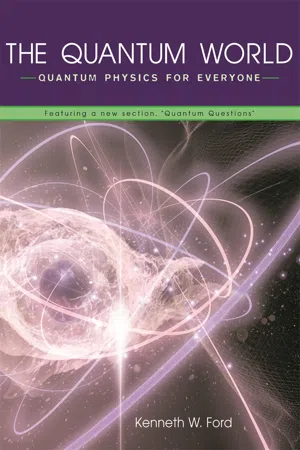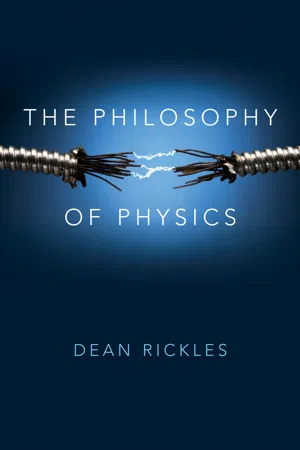Physics
Rotational Invariance
Rotational invariance refers to the property of physical systems that remains unchanged under rotations. In physics, this concept is fundamental to understanding the symmetries and conservation laws of rotational motion. It implies that the laws of physics are the same regardless of the orientation of the system, providing a powerful tool for analyzing and solving problems involving rotational motion.
Written by Perlego with AI-assistance
Related key terms
Related key terms
1 of 4
Related key terms
1 of 3
3 Key excerpts on "Rotational Invariance"
- eBook - ePub
The Quantum World
Quantum Physics for Everyone
- Kenneth W. Ford(Author)
- 2005(Publication Date)
- Harvard University Press(Publisher)
all laws, are the same in frames of reference moving uniformly with respect to one another. It is when the principle of Lorentz invariance is extended to the laws of electromagnetism that the astonishing consequences of relativity theory, such as time dilation and space contraction, are revealed.You can see now that conservation laws and invariance principles, although different ideas, have common features. Both describe something that remains constant while other things change. Both, accordingly, bring simplicity to the description of nature. For an invariance principle, it is the laws of nature that remain unchanged; for a conservation law, it is one specific physical quantity that remains unchanged. The change referred to by an invariance principle is change of conditions under which an experiment is performed; the change referred to by a conservation law is the physical change that occurs as a process unfolds. Notice also the difference between what is general and what is specific. The invariance principle: all laws remain unchanged for one particular change of conditions. The conservation law: one quantity remains unchanged for all possible physical processes.Absolute Conservation Laws and Invariance Principles
The “big four” conserved quantities of the large-scale world—energy, momentum, angular momentum, and charge—are also conserved in the subatomic world. This is no surprise, for everything in the large-scale world is built ultimately of subatomic units. So you can think of the causal link going from small to large: energy, momentum, angular momentum, and charge are conserved in the large-scale world because they are conserved in the subatomic world. The conservation laws that govern these quantities are regarded as absolute. An absolute conservation law is one for which no confirmed violation has ever been seen and which is believed to be valid under all circumstances. Moreover, we have theoretical reason to believe that these four laws are absolute. Relativity and quantum theory join to predict that these laws should - eBook - ePub
- Dean Rickles(Author)
- 2016(Publication Date)
- Polity(Publisher)
Transformation laws link the various reference frames, and allow us to see that the physical quantities that we measure do not depend on the frame in which they are measured: we extract the physical structure as that which is left invariant between the frames. As we see in the next chapter, these amount to symmetry principles. These high-level laws are then defined by invariance with respect to some class of transformations (some way of shifting, rotating, evolving, twisting, or otherwise morphing the system), in which case we say that the laws in question are covariant with respect to those transformations – with the systems themselves then said to be invariant rather than covariant (the relevant quantities of the systems, such as energy or momentum, are then said to be conserved). In the case of special relativity above, the task was to find a set of transformation laws that preserve the principles (given that those principles seem to have a solid status in reality, as revealed by experiment). These are known as the Lorentz transformations, which Einstein encoded into the structure of spacetime (thus providing an entirely new kinematic framework for considering the motion of bodies in space and time). In the case of Newton’s equations of motion one has to find transformation laws that preserve those equations – these are the so-called Galilean transformations (discussed in the next chapter: for now, think of these, and the Lorentz transformations, simply as ways of moving a system around in space and time). We can, given this, rewrite the principles from above as: G Galilean relativity → The covariance of the equations of motion (laws) under Galilean transformations. SR Special relativity → The covariance of the equations of motion (laws) under Lorentz transformations. These relativity principles bring into center stage the specific reference frames as characterized by their invariance under some specific set of transformations - eBook - ePub
- Emile Meyerson(Author)
- 2013(Publication Date)
- Routledge(Publisher)
One can be assured of this last fact by direct experiments, with the aid, for instance, of Foucault’s pendulum or gyroscope,(74) instruments which, we know, indicate the absolute velocity of the motion of rotation and not only, as is the case when we consider rectilinear velocities, modifications of velocity. The principle of inertia consists in this case in affirming that in respect to such a fundamental body or to a system of co-ordinates which are connected with it and which Streintz designates as a “fundamental system of co-ordinates,” any other body, if it is not subject to influences from without, will move in a straight line and with a uniform velocity. Ludwig Lange considers the motions of three “material points” upon three straight lines which meet in a point, and relates the motions of all the other bodies to this “inertial system.” The supposition that these three original points follow a uniform motion in a straight line is a convention; if it is accepted, the analogous statement for other bodies can be considered as a truth proved by experiment. Streintz’s system has the great advantage of being somewhat in conformity with the manner in which we do actually proceed. To calculate motions on the earth, we most often use co-ordinates attached to this latter, without taking account of rotation, as we know from experience that the motion of a point of the terrestrial surface can be considered, in these cases, as inertial, because of the small angular velocity. For astronomical measures we use co-ordinates oriented by points of reference of the celestial vault; this has the advantage of permitting a very rigorous determination. But that is because we have the conviction, confirmed by the experiment of Foucault, that it is these co-ordinates which regulate the planes of rotation
Index pages curate the most relevant extracts from our library of academic textbooks. They’ve been created using an in-house natural language model (NLM), each adding context and meaning to key research topics.
Explore more topic indexes
Explore more topic indexes
1 of 6
Explore more topic indexes
1 of 4


